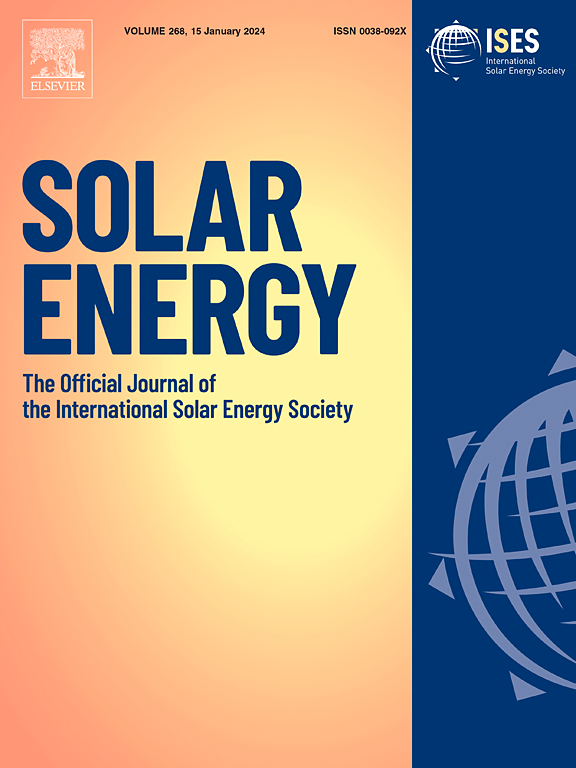与地球空气热交换器集成的锯齿形和光电屋顶型温室的热性能和经济性分析
IF 6
2区 工程技术
Q2 ENERGY & FUELS
引用次数: 0
摘要
在本研究中,根据热性能、日照利用率、番茄作物产量和经济性等方面,对热带气候下的单跨锯齿形温室和光伏屋顶温室进行了比较。在夏季自然循环模式下,锯齿形温室内作物高度处的平均温度、光照水平和相对湿度分别为 38.5 °C、10,000 Lux 和 30%。光伏屋顶温室内作物高度处的平均温度、光照强度和相对湿度分别为 40.2 °C、8000 Lux 和 28%。采用 EAHE 辅助雾化技术的锯齿形温室和光伏屋顶型温室的内部温度分别比环境温度低 10 ℃ 和 12 ℃。在下午时段,EAHE 的最大性能系数(COP)为 2.52。室内温度低于 35 °C、相对湿度介于 60-70 % 之间、光照强度高于光补偿点、光照时间为 8-10 小时/天的有利环境使锯齿形和光伏屋顶型温室的番茄产量比室外条件高出 32%。CFD 模拟显示,温室内再循环区的存在对均匀的温度分布起着至关重要的作用。在这些再循环区,空气沿着迂回路线到达出口,通风率由空气停留时间决定。光伏屋顶式温室减少了进入土壤的入射太阳辐射,从而创造了更好地利用地对地热交换器的环境。采用 EAHE 的锯齿形温室和光伏屋顶温室的折现投资回收期分别为 5.4 年和 5.2 年。然而,对于与 EAHE 系统集成的大型光伏屋顶温室农场,可以实现更有利的成本效益分析和更短的投资回收期。本文章由计算机程序翻译,如有差异,请以英文原文为准。
Thermal performance and economic analysis of saw-tooth and photo-voltaic roof type greenhouse integrated with Earth air heat exchanger
In the present study, comparison of single span saw-tooth and PV-roof type greenhouse assisted with Earth air heat exchanger (EAHE) was carried out for tropical climate based on thermal performance, sunlight availability, tomato crop yield and economical aspects. For natural circulation mode in summer, the average temperature at crop height, light illumination level and relative humidity inside sawtooth type greenhouse was 38.5 °C, 10,000 Lux and 30 % respectively. For PV-roof type greenhouse, the average temperature at crop height, light intensity and relative humidity was 40.2 °C, 8000 Lux and 28 % respectively. The sawtooth and PV-roof type greenhouse with EAHE assisted mist fogging was able to maintain inside temperature 10 °C and 12 °C below the ambient conditions respectively. The maximum coefficient of performance (COP) of EAHE was 2.52 in the afternoon hours. The conducive environment with indoor temperature below 35 °C, relative humidity between 60–70 %, sufficient light intensity levels above the light compensation point and duration of exposure of 8–10 h/day led to 32 % higher tomato yield from the saw-tooth and PV-roof type greenhouse compared to the outdoor conditions. The CFD simulations revealed that the presence of recirculation zones within the greenhouse played crucial role for the uniform temperature distribution. In these recirculation zones air followed a circuitous route to the exit and ventilation rate was governed by the air residence time. The reduced incident solar radiation access to the soil for PV roof type greenhouse had created an environment that allowed better exploitation of the earth-to-ground heat exchanger. The discounted payback period for the saw-tooth type and PV roof type greenhouse with EAHE was 5.4 years and 5.2 years respectively. However, for a large-scale PV-roof greenhouse farm integrated with EAHE system, a more lucrative cost benefit analysis and improved payback period can be achieved.
求助全文
通过发布文献求助,成功后即可免费获取论文全文。
去求助
来源期刊

Solar Energy
工程技术-能源与燃料
CiteScore
13.90
自引率
9.00%
发文量
0
审稿时长
47 days
期刊介绍:
Solar Energy welcomes manuscripts presenting information not previously published in journals on any aspect of solar energy research, development, application, measurement or policy. The term "solar energy" in this context includes the indirect uses such as wind energy and biomass
 求助内容:
求助内容: 应助结果提醒方式:
应助结果提醒方式:


